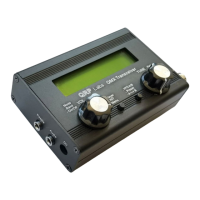TCXO frequency
25,000,000
Default is 25000000 (25 MHz). This is the oscillation frequency of the QMX TCXO (Temperature
Controlled Crystal Oscillator) and is used for calculating Si5351A parameters for setting the
desired QMX operating frequency.
The supplied TCXO is a high precision component and will normally be found to be within (a one
standard deviation error of) +/- 5 Hz of the specified 25 MHz value. It is not normally particularly
necessary from an operating perspective, to have a more precise operating frequency than this.
Remember that the error is also scaled to the operating frequency. So a 5 Hz error at 25 MHz will
translate to a 2.8 Hz error at 14 MHz.
However the perfectionists among you may wish to calibrate your operating frequency precisely –
and this menu entry is for you!
To configure the correct TCXO reference frequency, you will need to measure your operating
frequency, deduce the error amount, and apply a correction to the TCXO frequency configuration
parameter.
As an example, suppose your transceiver is set to a USB “Dial Frequency” of 14.0956 MHz and
WSJT-X is set up to transmit WSPR at 1500 Hz audio offset. This should result in a transmission
frequency of 14.097100 MHz. But let’s suppose that you measure it accurately, and you find that it
is 3 Hz high, at 14.097103 MHz. Now what?
There’s an error of +3 Hz in your operating frequency. To work out the required correction to the
TCXO reference frequency configuration, calculate 3 Hz multiplied by a ratio of 25 MHz / 14.0971
MHz, which results in 3 Hz x 1.77 = 5.3 Hz. Therefore you should increase the reference
frequency by 5Hz. So edit the TCXO frequency to 25,000,005.
How about if you don’t have an accurate way of measuring your operating frequency? I have
developed tools for QRP Labs website to help you to use the WSPRnet reporting network to
determine your operating frequency quite accurately. To use these tools, simply use WSJT-X and
QMX to operate as a 20m WSPR reporter (receiver) for several minutes, then look at this page:
https://qrp-labs.com/images/wsprnet/rxerror.html
Look for your callsign in the list, which shows the error in your reception reports (operating
frequency error). Alternatively, you may operate as a WSPR transmitter using WSJT-X and QMX,
and the following page will show your actual transmitting frequency:
https://qrp-labs.com/images/wsprnet/txfreq.html
Both of these QRP Labs pages are updated every two minutes. The analysis loads the last 2
minutes (approximately) of 20m WSPR reports from the WSPRnet website database. It
crossreferences all the reports, analyzing the error of receiver stations by cross-referencing
against reports of the same transmitters by other stations. In this way calibration errors of all
receiving stations in the network are averaged out. The accuracy is generally within 1 or 2 Hz.
QMX operang manual; rmware 1_00_012 42

